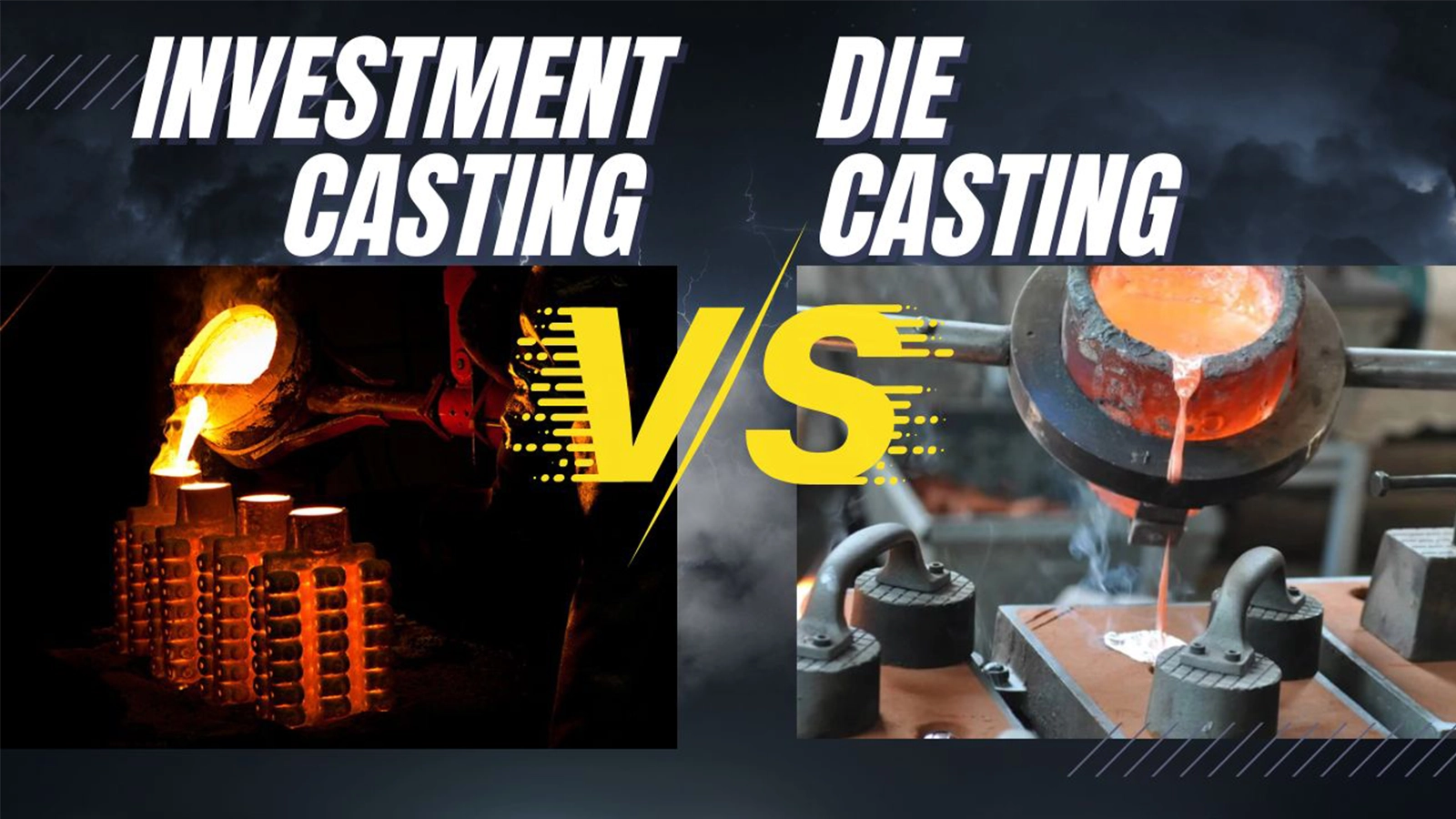Have you ever wondered how complex, high-precision metal parts are made with such accuracy? What makes investment casting stand out as a method for creating intricate shapes and detailed features? And how does this process achieve such high-quality results across industries like aerospace, automotive, and medical? If you’re looking for answers to these questions, you’ve come to the right place.
The investment casting process—also known as lost-wax casting—is a versatile manufacturing technique that allows for the creation of detailed and complex metal parts with high precision. From pattern creation to the final casting, this process offers numerous benefits, including tight tolerances, smooth surface finishes, and the ability to work with a wide variety of materials, such as stainless steel, aluminum, and titanium. Whether you’re a seasoned professional or a newcomer, understanding how investment casting works is essential for mastering this reliable technique.
Now let’s dive deeper into the investment casting process. This guide will take you step-by-step through each stage of the process, from pattern creation to finishing, helping you unlock the potential of this advanced method for producing flawless, high-quality metal parts. By the end, you’ll have a thorough understanding of the process and how it can be applied to your projects.
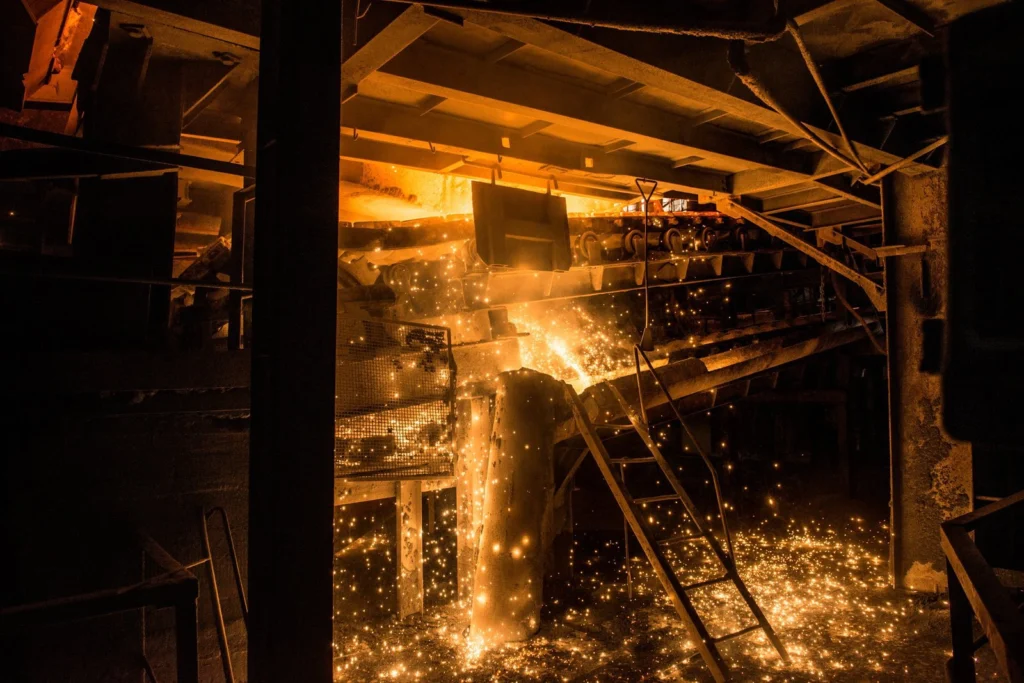
History and Evolution of Investment Casting
Origins of Investment Casting
Have you ever wondered what investment casting is and how it evolved into the sophisticated process we know today? Investment casting, also known as lost-wax casting, has ancient origins. The earliest known uses of this technique can be traced back to ancient Egypt, where it was used to create small metal objects like jewelry, tools, and religious artifacts. These objects required fine detail, which made investment casting the perfect method. The process involved creating a wax pattern, coating it with a fine material, and then melting the wax to leave a cavity that could be filled with molten metal.
This ability to achieve intricate shapes and high precision through investment casting made it highly sought after for both decorative and functional pieces. As civilizations advanced, so did the need for more complex metal parts, and investment casting continued to play a crucial role in producing parts that were both detailed and durable.
Need Help? We’re Here for You!
The Evolution of Investment Casting
So, how did investment casting transform into a widely used process in modern industries? Over time, investment casting became a highly reliable technique in engineering. During the Industrial Revolution, advancements in materials and technology pushed the boundaries of what was possible with this technique. The use of ceramic shells in the early 1900s was a significant turning point. These shells allowed for the creation of even more intricate patterns, which was essential as industries like aerospace and automotive grew in complexity.
The investment casting process also evolved with better metal alloys and more advanced tools. This evolution made investment casting an ideal method for producing high-precision parts with complex geometries. Key industries began to rely on investment castings for parts such as turbine blades, valve components, and engine parts that required not only high precision but also high strength.
Modern-Day Applications and Innovations
In the 21st century, the investment casting process has seen groundbreaking innovations. The integration of 3D printing investment casting has allowed manufacturers to create even more complex parts with exceptional accuracy and efficiency. Today, investment casting is used extensively across industries such as aerospace, automotive, medical, and petrochemical. From producing stainless steel investment castings for turbines to creating medical implants, this technique continues to offer unmatched versatility.
Modern investment casting can handle a wide range of materials, including aluminum investment casting, titanium, and nickel alloys, which are essential in producing parts that need to withstand extreme environments. As technologies advance and new materials become available, the potential of investment casting expands even further. It’s clear that the investment casting process is far more than just a historical technique—it’s a vital part of the manufacturing world today.
Understanding the Investment Casting Process
What is Investment Casting?
So, what is investment casting, and how does it work? Investment casting, also known as lost-wax casting, is a manufacturing process used to produce intricate and high-precision metal parts. It’s called investment casting because the metal is “invested” in a mold made from a wax pattern. This technique allows manufacturers to create parts with complex geometries, fine details, and tight tolerances. It’s an ideal method when precision is required, whether it’s for industrial components or artistic sculptures.
At its core, the process involves creating a wax model of the component, coating it in a ceramic shell, melting the wax to leave a cavity, and then pouring molten metal into the cavity to create the final part. The result is a part with high accuracy, minimal waste, and excellent surface finishes.
How Does Investment Casting Work?
So, how does the investment casting process unfold in practice? It begins with the creation of a wax pattern, which is an exact replica of the part you want to produce. The pattern is then repeatedly dipped in a slurry made of fine sand and ceramic material, followed by drying and hardening to form the mold. The mold is then baked to remove the wax and harden the shell, creating a solid, hollow cavity in the shape of the original pattern.
After the wax is removed, molten metal is poured into the mold. The metal fills the cavity, taking the shape of the pattern. After cooling and solidifying, the mold is broken away, leaving behind a metal part that is nearly identical to the original design. Depending on the material used—such as stainless steel investment casting or aluminum investment casting—the final part can be machined or polished to meet specific requirements.
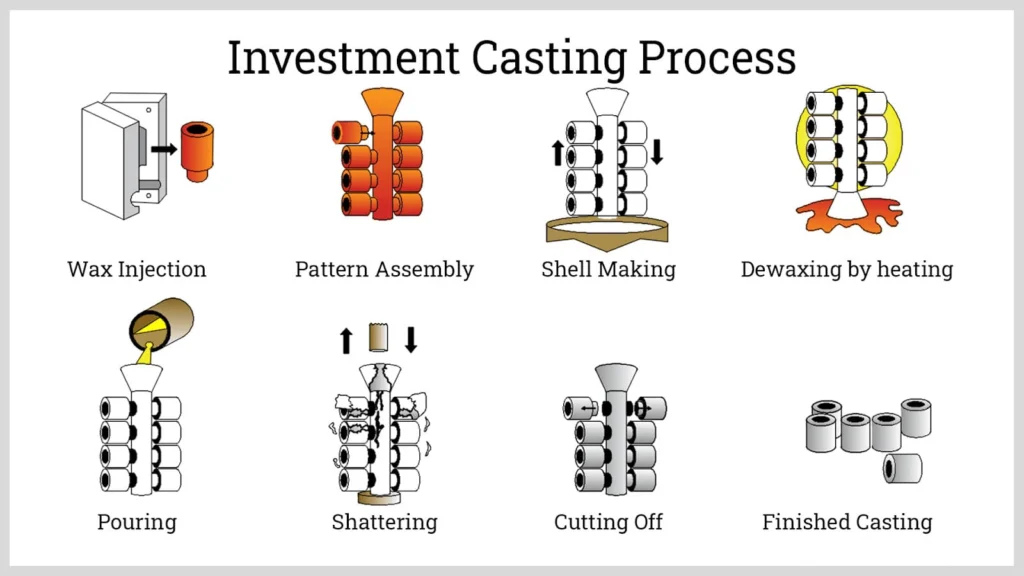
Key Steps in the Investment Casting Process
Pattern Creation:
The first step is creating the pattern, which is typically made of wax or a similar material. This pattern can be formed through injection molding or handcrafting, depending on the complexity of the part.
Shell Building and Wax Removal:
After the pattern is created, it is coated with a fine layer of ceramic material. This shell is built up through several layers, each hardened before applying the next. Once the shell is thick and durable, the wax is melted away, leaving behind the mold.
Metal Pouring and Cooling:
The next step involves heating the mold to the proper temperature and then pouring molten metal into it. The metal flows into the cavity left by the wax pattern and takes its shape as it cools and solidifies.
Shell Removal and Finishing:
After the metal has cooled, the ceramic shell is broken away. The part may then undergo various finishing processes, such as cleaning, machining, and polishing, to achieve the desired dimensions and surface finish.
Materials Used in Investment Casting Process
Metals and Alloys in the Investment Casting Process
The investment casting process is renowned for its ability to work with a wide variety of materials, making it highly versatile for different industries. The materials used in the investment casting process are carefully selected based on the performance and durability required for the final part. Common metals used in the process include stainless steel, aluminum, titanium, and nickel alloys, each providing unique benefits for specific applications.

Stainless Steel Investment Casting
Stainless steel is one of the most widely used materials in the investment casting process due to its exceptional corrosion resistance, strength, and ability to withstand harsh environments. This material is often used in applications such as valves, pumps, and medical devices, where long-lasting durability is crucial.
Aluminum Investment Casting
Aluminum is a lightweight material with excellent corrosion resistance and is ideal for investment casting in industries like automotive and aerospace, where weight reduction is essential. Its machinability and smooth finish make it a popular choice for parts like engine components and structural elements.

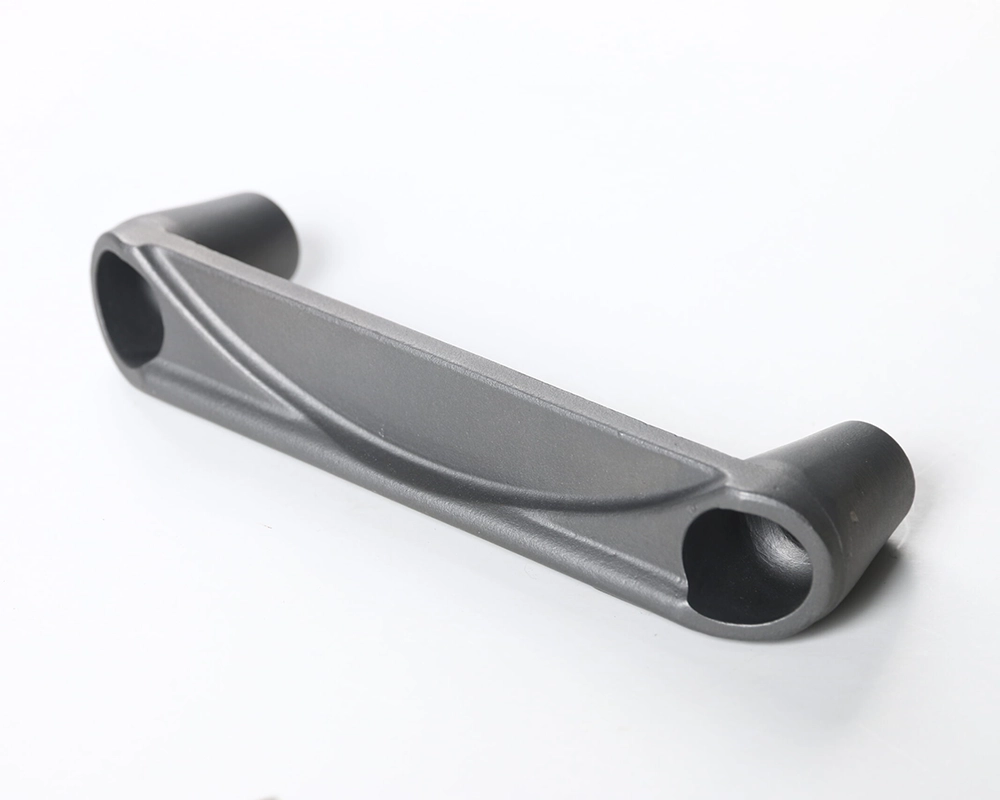
Titanium Investment Casting
Titanium is a high-performance metal known for its strength, light weight, and ability to withstand extreme temperatures. In the investment casting process, titanium is often used for aerospace parts and medical implants, where its high strength-to-weight ratio is essential for performance and safety.
Nickel Alloys
For parts that need to endure high temperatures, nickel alloys are often chosen in the investment casting process. These alloys are typically used in industries like power generation, aerospace, and gas turbines, where components must resist heat, oxidation, and corrosion.
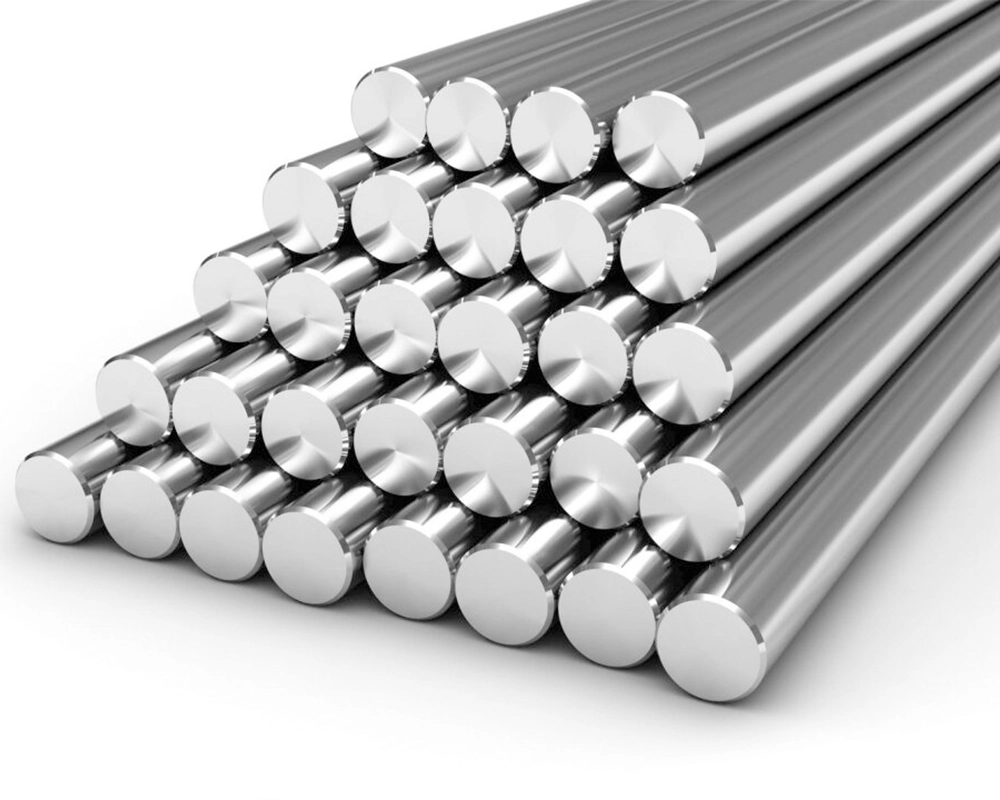
Why These Materials are Used in the Investment Casting Process
Each material used in the investment casting process plays a significant role in determining the performance of the final part. The key to selecting the right material lies in understanding the specific benefits each offers:
- Stainless Steel: Known for its outstanding corrosion resistance, stainless steel is perfect for parts that need to withstand harsh chemical environments, such as medical devices or marine components.
- Aluminum: Due to its lightweight nature and corrosion resistance, aluminum is commonly used in aerospace applications, where weight reduction without compromising strength is essential. It’s also widely used for automotive parts, where fuel efficiency and performance are key.
- Titanium: Titanium is favored for applications requiring high strength and heat resistance, making it the material of choice in industries like aerospace and medical implants. Its strength and low density allow for stronger, lighter components in critical applications.
- Nickel Alloys: With their ability to withstand extreme temperatures, nickel alloys are essential in the investment casting process for high-stress applications, such as turbine blades, gas engines, and other components exposed to extreme heat.
Need Help? We’re Here for You!
The Role of Investment Casting Wax in the Process
In addition to the metals, the investment casting wax is a vital component in the process. The wax forms the pattern that will eventually become the mold for the metal part. The investment casting wax needs to hold fine details and allow easy removal after it has served its purpose in the mold creation.
- Wax Properties: The investment casting wax is typically composed of paraffin and other materials that make it suitable for molding the pattern. The wax must be durable enough to maintain the shape of the pattern but also melt away easily without leaving residue, ensuring a clean, high-quality mold.
- Wax Selection for Investment Casting: The choice of wax material can impact the investment casting process. Different types of waxes are selected based on the complexity and size of the pattern being created. The right wax ensures that the mold can achieve the required precision and detail, which is crucial for the final product’s performance.
Specialty Materials for High-Performance Investment Casting
For certain applications requiring even more advanced material properties, investment casting can use specialty materials such as superalloys or cobalt alloys.
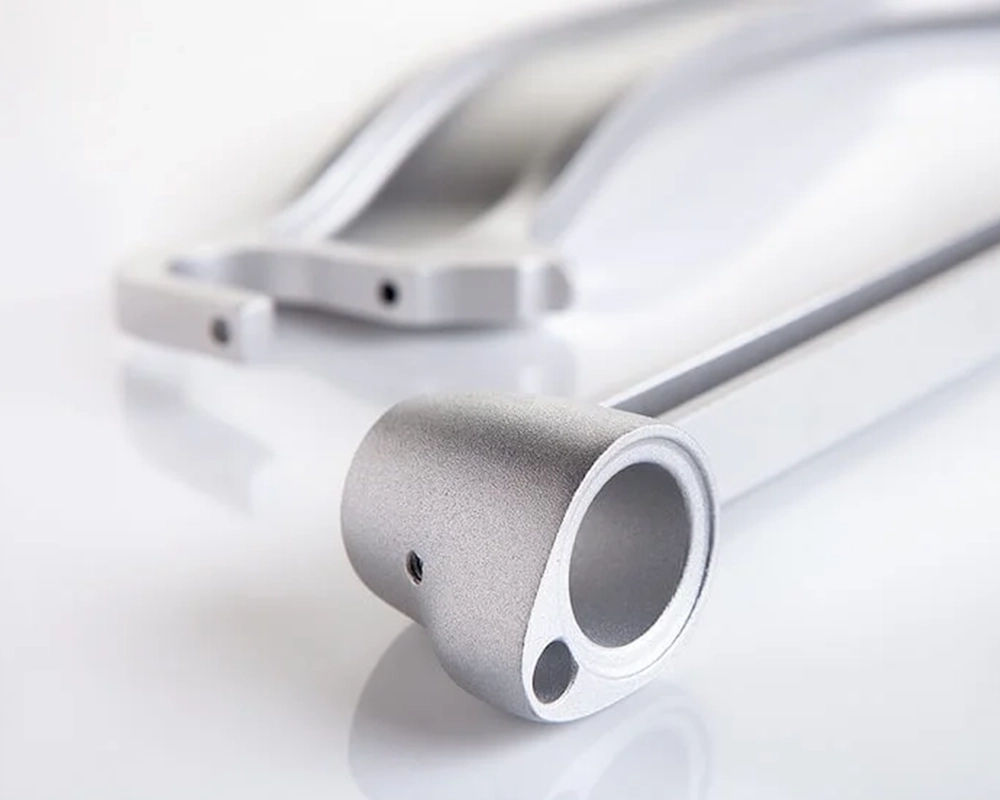
Superalloys
Used primarily in the aerospace and power generation industries, superalloys can endure extreme temperatures and provide exceptional strength in high-stress environments. The investment casting process allows these materials to be molded into highly detailed components such as turbine blades and other critical parts.
Cobalt Alloys
Cobalt alloys are known for their ability to resist wear, corrosion, and high temperatures. In the investment casting process, they are used for parts that require both strength and durability, like valve components and medical implants.

Advantages of the Investment Casting Process
The investment casting process offers numerous benefits that make it one of the most reliable and versatile methods for producing high-precision metal parts. Whether it’s used for small batch runs or large-scale production, the investment casting process provides advantages that other manufacturing methods, such as sand casting or die casting, cannot match. Below are some of the key advantages of using the investment casting process.
High Precision and Tight Tolerances
One of the biggest advantages of the investment casting process is its ability to achieve high precision and tight tolerances. Parts created through investment casting typically require minimal post-processing, reducing both labor costs and production time. The molds used in the process can capture fine details, allowing manufacturers to create parts that meet strict dimensional requirements. This makes investment casting ideal for applications in industries like aerospace, automotive, and medical, where precision is crucial.
For instance, components like turbine blades, medical implants, and engine parts require very high dimensional accuracy to function correctly. The investment casting process can achieve tolerances as tight as ±0.05 mm, which is extremely challenging for many other casting methods to match.
Complex Geometries and Detailed Features
Another major benefit of the investment casting process is its ability to produce parts with complex geometries and detailed features. Unlike traditional sand casting or die casting, which may require additional steps to achieve intricate shapes, investment casting allows for the creation of components with fine features, including internal cavities, thin walls, and undercuts.
For example, the investment casting process can produce parts such as valves, pump bodies, and aerospace components with complex internal features that are impossible or costly to achieve using other casting methods. The ability to create complex parts in a single step reduces assembly time and enhances the overall efficiency of the manufacturing process.
Minimal Material Waste
The investment casting process is an efficient method in terms of material usage. Since the molds are made with high accuracy, there is minimal material waste during production. The molten metal fills only the cavity left behind by the wax pattern, with very little excess material that needs to be disposed of or recycled. This is especially beneficial when working with expensive materials like titanium, stainless steel, or nickel alloys, where minimizing waste helps keep costs down.
Additionally, investment casting is an environmentally friendly option when compared to other casting methods that generate significant waste or require additional processing to remove excess material. The reduced waste and energy efficiency make it an attractive option for industries focusing on sustainability.
Reduced Post-Processing and Machining
Thanks to the investment casting process’s precision, parts often require minimal post-processing. This can significantly reduce production time and costs. The surface finish of parts produced through the investment casting process is typically much smoother than parts made using sand casting or die casting, often requiring little or no machining.
For example, stainless steel investment castings used in industries like medical devices or aerospace often have near-net shapes that are ready to be used without further machining. This makes the investment casting process an ideal choice for parts that require complex shapes and fine surface finishes with reduced secondary operations.

Get Your Free Catalog Now!
Material Flexibility
The investment casting process is highly flexible in terms of material selection. A wide variety of metals and alloys can be used, including stainless steel, aluminum, titanium, nickel alloys, and even superalloys for high-performance applications. This flexibility allows manufacturers to choose the best material for each specific application, based on factors like strength, corrosion resistance, and temperature tolerance.
For instance, aluminum investment casting is ideal for lightweight applications in the automotive industry, while nickel alloy investment casting is essential for parts used in high-temperature environments, such as jet engines. The investment casting process makes it possible to produce parts with different material properties from a single casting process, saving both time and money.
Cost-Effectiveness for Low-Volume Production
While many casting processes are more cost-effective at high volumes, the investment casting process stands out for its ability to remain cost-effective for low to medium volume production as well. This makes it an attractive option for industries requiring high-precision, low-volume parts. Components like prototype parts and limited-run custom parts can be efficiently produced through the investment casting process without incurring the high tooling costs often associated with other casting methods.
The investment casting process is also effective for creating complex parts that would otherwise require multiple manufacturing steps in other methods, helping companies save on labor and time. The reduction in post-processing also lowers costs, making investment casting a more affordable option for producing high-precision parts in low quantities.
Versatility in Applications
The investment casting process is a versatile manufacturing method, making it suitable for a wide range of industries and applications. From aerospace components to medical implants, the ability to create detailed, complex parts with minimal waste and high precision makes investment casting the method of choice for many sectors.
In addition to traditional industries, newer applications, such as 3D printed molds for investment casting, are expanding the range of what can be achieved with this technique. This versatility ensures that the investment casting process continues to be an essential tool in modern manufacturing.
Applications of Investment Casting in Various Industries
The investment casting process is used across a wide range of industries due to its versatility and ability to produce high-precision components. This method excels at creating parts with complex shapes, fine details, and tight tolerances—qualities that are essential in critical industries such as aerospace, automotive, medical, and energy. Below are some of the key industries where investment casting plays a vital role.
Aerospace Industry
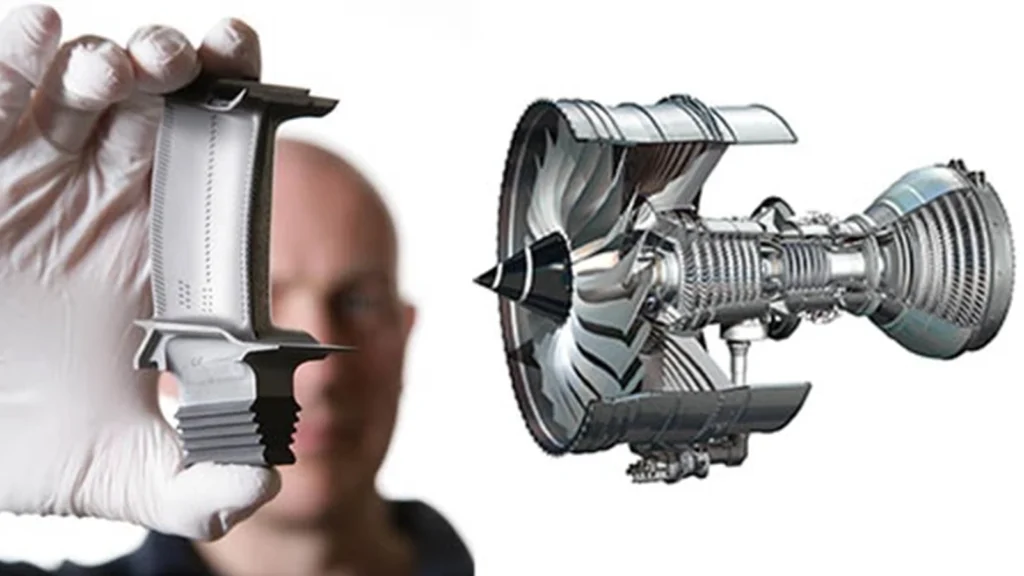
In the aerospace industry, where performance and safety are paramount, the investment casting process is essential for manufacturing complex, high-performance parts. The ability to produce components with intricate geometries and tight tolerances makes investment casting ideal for producing turbine blades, fuel nozzles, and engine components. These parts are exposed to extreme conditions, including high temperatures and stress, so the materials used—such as nickel alloys and titanium—must be strong, heat-resistant, and durable.
The investment casting process is particularly useful in aerospace because it can produce high-strength parts with minimal material waste, reducing the overall cost and improving manufacturing efficiency. Moreover, investment casting allows for the creation of parts that are both lightweight and highly resistant to wear and corrosion, which are essential properties in the aerospace sector.
Automotive Industry
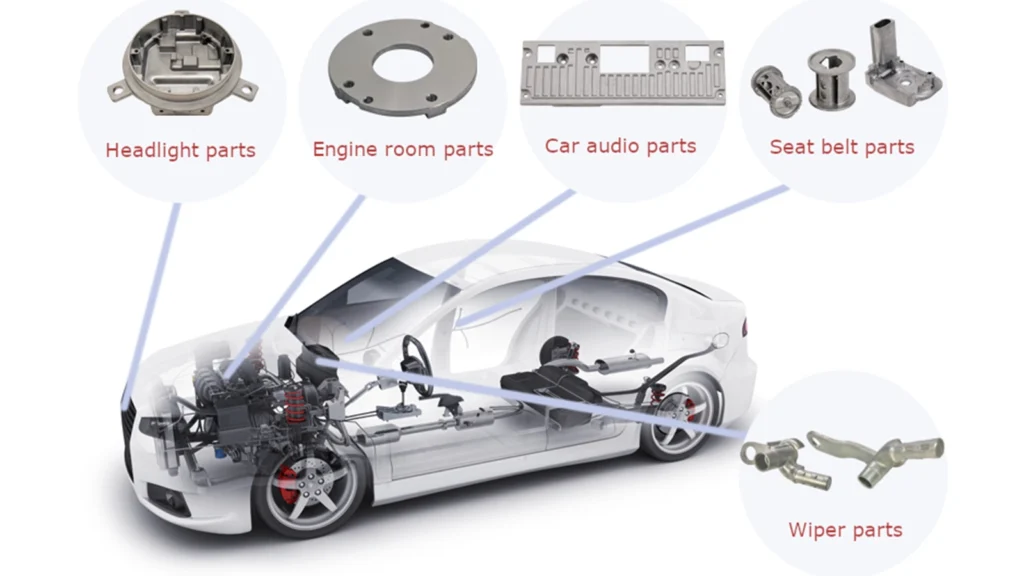
The investment casting process is a widely used method in the automotive industry, where precision and performance are key. Parts such as engine blocks, brake components, gears, and valve bodies are commonly produced using investment casting. The process is ideal for creating lightweight, strong components that can withstand the high stresses and wear typically experienced in automotive engines and machinery.
For example, aluminum investment casting is commonly used in the production of automotive components due to its lightweight properties, which help improve fuel efficiency and reduce overall vehicle weight. Stainless steel investment casting, on the other hand, is frequently used for parts that need to resist corrosion, such as exhaust components and fuel systems.
Medical Industry

The investment casting process is particularly valuable in the medical industry, where precision and biocompatibility are critical. Medical implants, such as joint replacements, dental implants, and surgical tools, are often made using investment casting because it allows for the creation of complex shapes with high dimensional accuracy. The process also provides a smooth surface finish, which is important for both aesthetic and functional purposes.
Additionally, investment casting allows manufacturers to work with specialized materials such as titanium or cobalt-chrome alloys, which are known for their biocompatibility and resistance to corrosion, making them ideal for medical devices. The ability to create parts with tight tolerances and complex internal features—like those needed in prosthetics—is a significant advantage of the investment casting process.
Energy and Petrochemical Industries
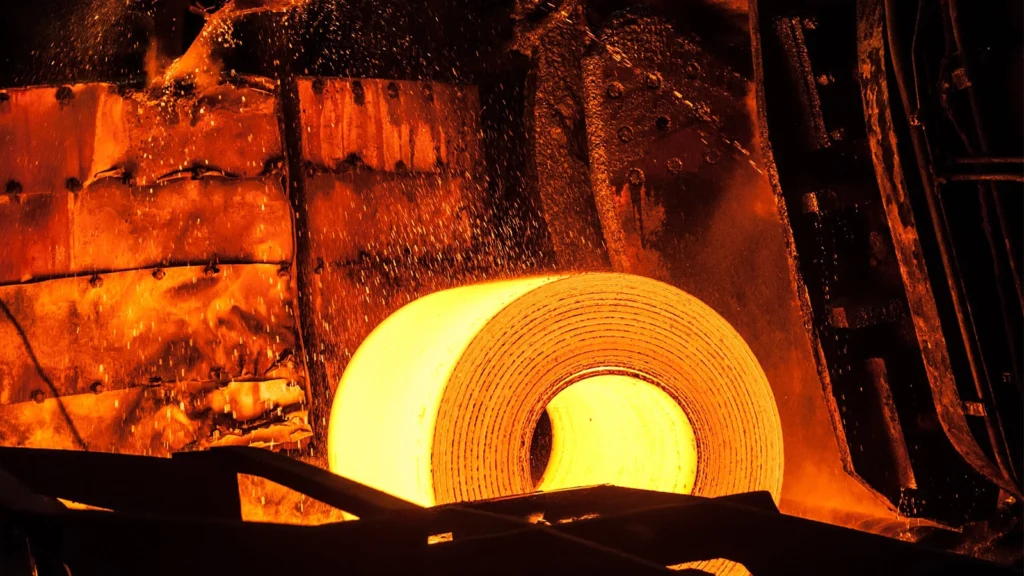
The energy and petrochemical industries rely on the investment casting process to produce durable and high-performance components that can withstand extreme conditions, such as high pressure, temperature, and corrosive environments. Parts like valves, pumps, flanges, and turbine blades are frequently manufactured using investment casting because they require precision and durability.
Nickel alloys, stainless steel, and superalloys are commonly used in these industries, as they offer the necessary strength and resistance to high temperatures and corrosion. The investment casting process allows these materials to be cast into complex shapes that are critical for the performance and safety of equipment used in power plants, chemical processing plants, and offshore oil rigs.
Art and Sculpture
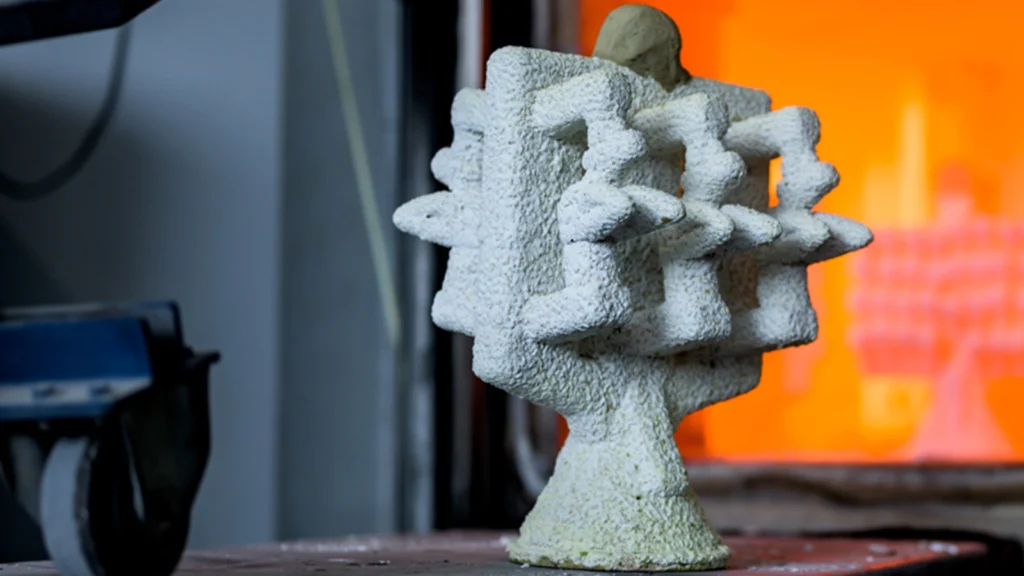
In addition to industrial applications, investment casting is also widely used in the creation of art and sculptures. Artists have used the investment casting process for centuries to produce intricate metal sculptures, medals, and decorative pieces. The ability to cast detailed patterns and shapes with fine detail and high precision makes investment casting ideal for creating complex artwork.
The process allows artists to work in a variety of metals, including bronze, brass, and silver, giving them the flexibility to create sculptures with different textures and finishes. Whether for artistic works, commemorative statues, or custom jewelry, the investment casting process offers the precision needed to bring detailed designs to life.
Other Industries
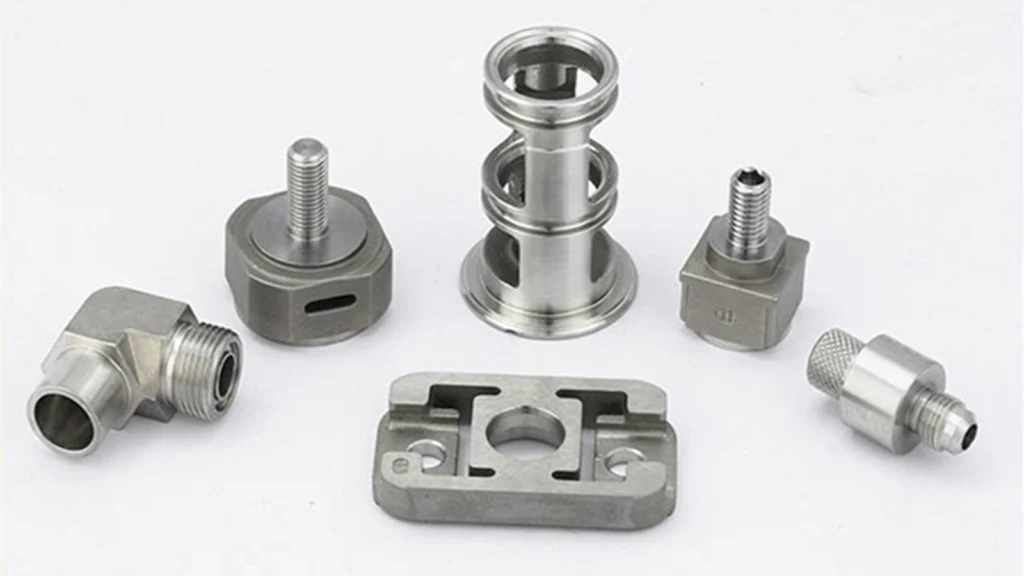
Apart from the industries mentioned, investment casting also finds applications in military (for components such as weapon systems), marine (for propellers and housings), and electronics (for components like connectors and enclosures). The process’s ability to handle various materials and create highly intricate designs makes it a versatile choice for many other sectors requiring precision metal parts.
Quality Control in Investment Casting
The investment casting process is known for its precision, but achieving high-quality results consistently requires stringent quality control measures. Ensuring that each part meets the required specifications, tolerances, and performance standards is essential to the success of the investment casting process. From material selection to final inspection, several steps are involved in maintaining quality throughout the production process.
Ensuring Dimensional Accuracy
One of the most critical aspects of investment casting is achieving dimensional accuracy. Because the investment casting process allows for high precision, the parts produced often require minimal post-processing. However, to ensure that the parts meet the required tolerances, manufacturers use advanced measuring tools and techniques. Coordinate Measuring Machines (CMM) are commonly used to check the dimensional accuracy of each part, ensuring it aligns with the digital model or engineering drawings.
The investment casting process itself contributes to the high degree of precision by creating molds from wax patterns that closely match the final part. The molding process, combined with careful material selection, results in parts that meet the tight tolerances required for industries such as aerospace, automotive, and medical devices.
Surface Finish Inspection
The quality of the surface finish is another important factor in investment casting. The investment casting process often produces parts with excellent surface finishes, reducing the need for additional finishing work. However, parts with certain features or specific requirements may still need to undergo further polishing or machining.
Visual inspection is the first step in ensuring that the surface finish meets the necessary standards. If a part has a rough or damaged surface, it may not perform as required in its intended application. Additionally, surface roughness tests using tools like profilometers can be conducted to ensure that the finish is within acceptable limits.
In industries like medical implants, where smoothness and biocompatibility are essential, achieving the right surface finish is a critical part of quality control in the investment casting process.

Get Your Free Catalog Now!
Material Testing and Inspection
The material used in the investment casting process plays a vital role in ensuring the final part meets performance and durability standards. As part of quality control, material testing is conducted to verify that the metal used in the investment casting process meets the required specifications. This can include tests such as:
- Tensile strength to measure the metal’s ability to withstand stretching.
- Hardness tests to ensure the material has the necessary resistance to wear.
- Chemical composition analysis to verify that the alloy contains the correct proportions of elements.
These tests help identify potential issues with material properties before the casting process is complete, ensuring that the final part will perform as expected in its end use.
X-Ray Inspection and Internal Defects Detection
The investment casting process is capable of producing highly complex parts with intricate internal geometries. However, ensuring that there are no internal defects—such as voids, cracks, or porosity—requires advanced non-destructive testing methods. X-ray inspection is commonly used to detect any internal flaws that might compromise the integrity of the part.
X-ray inspection allows manufacturers to visualize the internal structure of a part without damaging it. This is particularly crucial for industries like aerospace, where internal defects could lead to catastrophic failure. Other non-destructive testing methods, such as ultrasonic testing and dye penetrant inspection, are also used to detect surface and internal defects, ensuring that only high-quality parts reach the customer.
Final Inspection and Quality Documentation
Once a part has passed all the necessary tests and inspections, it undergoes a final inspection to ensure it meets all the required specifications. This includes verifying the dimensional accuracy, surface finish, and material integrity. After final inspection, quality documentation is often generated, detailing the tests conducted, results obtained, and any corrective actions taken.
This documentation serves as proof that the part meets the required standards and can be critical for industries like aerospace and medical, where traceability is essential for compliance with regulatory requirements.
The Role of Process Control in Investment Casting
Effective process control is essential for maintaining the quality and consistency of parts produced through the investment casting process. By continuously monitoring the temperature, material properties, and other parameters during the casting process, manufacturers can reduce variability and ensure that each part meets the required standards.
For example, controlling the temperature of the molten metal is crucial to avoid defects like inclusions or porosity. Likewise, ensuring the investment casting wax is properly injected and removed is crucial for achieving accurate molds. Automation and real-time monitoring are increasingly being used to improve process control and maintain high levels of consistency across production runs.
Troubleshooting Common Issues in Investment Casting
The investment casting process is highly precise, but certain common issues can arise during production. Below are some of the most frequent problems and their solutions:
Surface Defects
Surface defects like cracks, misruns, and cold shuts are often caused by improper temperature control or poor metal flow.
- Causes: Rapid cooling, low pouring temperature, or poor mold design.
- Solution: Ensure a controlled cooling rate, optimize pouring temperature, and improve mold design to facilitate smoother metal flow.
Inclusions and Contamination
Inclusions occur when foreign materials or debris are trapped inside the casting, weakening the part.
- Causes: Contaminated molten metal or moisture in the mold.
- Solution: Filter molten metal, clean the mold thoroughly, and ensure proper drying of investment casting wax patterns.
Porosity
Porosity refers to tiny holes in the casting, which can weaken the structure.
- Causes: Trapped air or gas in the mold due to poor venting or moisture.
- Solution: Vent the mold properly, degas the molten metal, and dry the molds and wax patterns thoroughly.
Shrinkage Defects
Shrinkage occurs when metal solidifies and contracts, leaving voids in the casting.
- Causes: Inadequate mold design or improper cooling.
- Solution: Design molds with risers and optimize cooling rates to reduce shrinkage.
Improper Gating
A poorly designed gating system can lead to defects like misruns or turbulence in the mold.
- Causes: Uneven metal flow due to poor gating design.
- Solution: Ensure proper gating system design for smooth and even metal flow into the mold.
Need Help? We’re Here for You!
Investment Casting vs Other Casting Processes
| Feature | Investment Casting | Sand Casting | Die Casting | Permanent Mold Casting |
|---|---|---|---|---|
| Precision | High precision with tight tolerances (±0.05 mm) | Lower precision, requires more post-processing | High precision, but less than investment casting | High precision, but lower than investment casting |
| Complexity of Parts | Excellent for intricate and complex geometries | Suitable for simple shapes with minimal detail | Good for medium complexity but lacks intricate detail | Ideal for simple to medium complexity parts |
| Material Range | Wide range: steel, aluminum, titanium, superalloys | Limited to ferrous and non-ferrous metals | Mostly non-ferrous metals like aluminum and zinc | Suitable for non-ferrous metals (aluminum, copper) |
| Surface Finish | Smooth surface finish, minimal post-processing | Rough surface, requires machining | Smooth surface finish with minimal machining | Moderate finish, some post-processing required |
| Casting Size | Small to medium parts | Large parts, up to several tons | Small to medium parts, typically under 10kg | Small to medium parts, typically under 20kg |
| Tooling Cost | High tooling cost due to detailed molds | Low tooling cost due to simple sand molds | High tooling cost for precision molds | Moderate tooling cost, reusable molds |
| Production Volume | Best for low to medium-volume production | Best for low-volume or prototype production | Best for high-volume production | Suitable for medium to high-volume production |
| Material Waste | Low material waste | Higher material waste due to rough castings | Low material waste with precise molds | Low material waste with precise molds |
| Casting Speed | Moderate, due to multiple steps (wax removal, mold hardening, etc.) | Slow, especially for large parts | Fast, ideal for high-speed production | Moderate speed, quicker than sand casting |
| Cost Efficiency | Cost-effective for small to medium-volume, high-precision parts | Cost-effective for low-volume, simple parts | Cost-effective for high-volume, simple parts | Moderate cost efficiency for medium-volume production |
Trends and Innovations in the Investment Casting Industry
The investment casting process continues to evolve with advancements in technology and materials. Key trends are shaping the future of the industry and improving efficiency, precision, and sustainability.

3D Printing in Investment Casting
3D printing allows for the creation of wax patterns with complex geometries, reducing production time and enabling faster prototyping.
- Benefit: Faster lead times and more intricate designs.
- Application: Custom parts in aerospace and medical industries.
High-Performance Alloys
The use of superalloys and nickel alloys in investment casting is increasing, especially in aerospace and power generation, due to their ability to withstand extreme conditions.
- Benefit: Stronger, more durable parts for high-stress applications.
- Application: Turbine blades, jet engines.
Automation and Robotics
The integration of robotics in the investment casting process is improving precision, consistency, and production speed by automating tasks such as pattern handling and pouring.
- Benefit: Increased efficiency and reduced labor costs.
- Application: Automotive and aerospace manufacturing.
Sustainability
The industry is focusing on green practices, including wax recycling and energy-efficient technologies, to reduce waste and environmental impact.
- Benefit: Reduced carbon footprint and cost savings.
- Application: Automotive and medical industries.
Digital Twin Technology
Digital twin technology allows manufacturers to simulate and optimize the investment casting process before production, improving quality control and reducing defects.
- Benefit: Enhanced precision and reduced scrap rates.
- Application: Aerospace and high-performance automotive parts.
Conclusion
The investment casting process continues to be an essential method for producing high-precision, complex metal components across a wide range of industries. With its ability to deliver intricate designs, tight tolerances, and strong material properties, investment casting is a go-to solution for applications in aerospace, automotive, medical, and more. As trends like 3D printing, automation, and sustainability continue to evolve, the investment casting process will remain at the forefront of modern manufacturing.
At DZS Metal, we pride ourselves on providing high-quality investment casting services with the precision and expertise required for the most demanding industries. Whether you’re in need of stainless steel, aluminum, or titanium investment casting, we offer tailored solutions to meet your exact specifications. Our state-of-the-art facilities, skilled team, and commitment to excellence ensure that your projects are completed on time and to the highest standards.

Partner with DZS Metal for your next investment casting project and experience unparalleled quality, reliability, and customer service. Contact us today to learn how we can help bring your designs to life with precision and efficiency.



